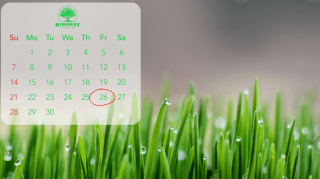At Strobert Tree Services, we understand that a thriving lawn isn't just a pretty aesthetic; it's an integral part of a healthy ecosystem. Maintaining that lush green carpet underfoot requires more than just watering and mowing; it's about recognizing the intricate dance between grass growth and the well-being of the surrounding trees and plants.
Just as leaves change color and deciduous trees slumber through winter, grass also enters a period of dormancy. This slowdown isn't a sign of neglect but a crucial adaptation. Trees and plants reduce their resource demands as temperatures dip and sunlight weakens. This shift impacts the soil, altering nutrient availability and moisture retention and affecting grass growth.
With their robust root systems, healthy trees and plants contribute to a balanced soil environment. They act like natural filters, absorbing excess nutrients and pollutants. At the same time, their fallen leaves provide organic matter that nourishes the soil and helps retain moisture. This fertile ground supports healthy grass growth, creating a symbiotic relationship that benefits the landscape.
By understanding this interconnectedness, we can approach lawn care holistically. Pruning overgrown trees allows more sunlight to reach the grass while maintaining healthy plant diversity, contributing to a balanced soil microbiome. This, in turn, fosters optimal conditions for a vibrant and resilient lawn, adding value to your property and the health of your entire ecosystem.
In temperate regions like Delaware, Pennsylvania, Maryland, and New Jersey, grass growth is most active during the spring and fall. These seasons provide the optimal combination of sunlight and moderate temperatures for photosynthesis, the process by which plants convert sunlight into energy.
How Temperature Affects Grass Growth
Cool-Weather Grasses:
- Peak Performance: Spring and Fall (50-75°F): Kentucky bluegrass, fescue, ryegrass - these stars take center stage, showcasing lush green blades and vigorous growth during these mild months.
- Slow Down: Summer (above 85°F): As the heat rises, cool-weather grasses gracefully step back, conserving energy and slowing growth to endure the scorching temperatures.
- Winter Dormancy: (below 40°F): When the frost nips at the air, cool-weather grasses enter a well-deserved slumber, protecting themselves until spring's return.
Warm-Weather Grasses:
- Peak Performance: Summer (80-95°F): Bermuda, Zoysiagrass, St. Augustine grass - these sun-worshippers come alive in the summer heat, their vibrant green carpets flourishing under the warm sun.
- Slow Down: Spring and Fall (below 70°F): As the temperatures dip, warm-weather grasses begin to wind down, their growth slowing but not completely stopping.
- Winter Dormancy: (below 60°F): When winter's chill arrives, even these heat-loving grasses enter a period of dormancy, albeit a shallower one compared to their cool-weather counterparts.
How Grass Growth Varies by Location
Understanding your grass type and local climate is essential in determining when the grass will stop growing in your area. Different regions experience varying temperature patterns and lengths of growing seasons. Coastal areas, for instance, may have milder temperatures, allowing for extended growing periods compared to inland regions with more drastic temperature fluctuations.
When to Do Your Last Mow of the Season
Adjusting your lawn care routine becomes crucial as the seasons change and temperatures drop. One of the critical practices during the transition from fall to winter is determining the right time for your last mow of the season.
We recommend mowing cool-season grasses until they reach a height of around 2.5 to 3 inches before winter sets in. This height provides a sufficient buffer against the challenges of cold weather. It reduces the risk of diseases like snow mold. On the other hand, warm-season grasses can be mowed slightly lower, around 1.5 to 2 inches, before entering dormancy.
Performing your last mow appropriately helps prevent excessive thatch buildup and maintains an aesthetically pleasing lawn. Leaving grass too long going into the winter can create an environment conducive to snow mold and other diseases, while cutting it too short may expose the roots to harsh winter conditions.
Contact Strobert Tree Services - Leaders in Tree Care
At Strobert Tree Services, we understand the importance of comprehensive lawn care. While our expertise lies in tree care, we recognize the interconnected nature of landscaping. Our services extend to Delaware, Pennsylvania, Maryland, and New Jersey, encompassing a range of arboricultural solutions.
Whether you need tree pruning, removal, or general advice on maintaining a healthy outdoor space, our professionals are ready to assist you. We pride ourselves on being leaders in the industry, committed to the well-being of your trees and lawn. Contact Strobert Tree Services today to ensure your outdoor spaces thrive throughout every season.
The timing of when the grass stops growing is intricately linked to seasonal variations, temperature fluctuations, and the grass type in your lawn. By staying informed and tailoring your lawn care practices to these factors, you can promote a lush, resilient lawn that stands the test of time.











